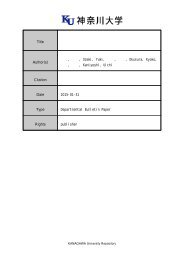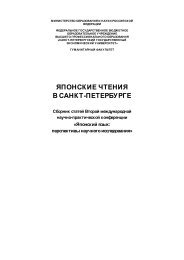to Learners with Special Educational Needs
e-textbook SEN
e-textbook SEN
You also want an ePaper? Increase the reach of your titles
YUMPU automatically turns print PDFs into web optimized ePapers that Google loves.
Pokrivčáková, S. et al. (2015). Teaching Foreign Languages <strong>to</strong> <strong>Learners</strong> <strong>with</strong> <strong>Special</strong> <strong>Educational</strong> <strong>Needs</strong>:<br />
e-textbook for foreign language teachers. Nitra: Constantine the Philosopher University. 128 p.<br />
ISBN 978-80-558-0941-0<br />
Foreign language education of learners <strong>with</strong> special educational needs reflected in<br />
Slovak school legislation and state pedagogical documents<br />
Along <strong>with</strong> other European countries, foreign language education has become one of the<br />
priorities defined in Slovak school legislation. Changes in foreign language education have been<br />
in line <strong>with</strong> the long-lasting and systematic reform of Slovak school system (since 1989). The<br />
general aim of foreign language education in Slovakia has been highlighted in the basic<br />
document called The Conception of Foreign Language Education at Primary and Secondary<br />
Schools (Koncepcia…, 2007) as follows: “The general aim is <strong>to</strong> ensure reaching communicative<br />
levels B1 or B2 according <strong>to</strong> the Common European Framework of Reference for Languages<br />
(CEFR) in the first foreign language and communicative levels A2/B1 according <strong>to</strong> CEFR for<br />
languages in the second foreign language by all learners in the Slovak Republic at the end of the<br />
secondary school” (Koncepcia.., 2007). The main aim of the conception was <strong>to</strong> provide quality<br />
foreign language education for all primary and secondary learners, including those <strong>with</strong><br />
special educational needs. The other aims included the following: <strong>to</strong> unify foreign language<br />
syllabi at all types of schools; <strong>to</strong> maximize intensity and lower extensity (variants) of foreign<br />
language teaching programmes; <strong>to</strong> guarantee continuity of foreign language education in the<br />
first foreign language while passing from primary schools <strong>to</strong> secondary schools; and <strong>to</strong> ensure<br />
that secondary schools graduates will be able <strong>to</strong> communicate appropriately in two foreign<br />
languages <strong>to</strong> perform well in European labour markets.<br />
The Conception… (2007) has established the minimal target model of foreign language<br />
education which was introduced in<strong>to</strong> schools in September 2008. The model defines the<br />
compulsory start of foreign language education for all learners at least in the third year of the<br />
primary school. <strong>Learners</strong> are allowed <strong>to</strong> choose from 6 foreign languages: English, German,<br />
French, Russian, Spanish and Italian, according <strong>to</strong> the possibilities of the school. One of the later<br />
directives stated that all learners need <strong>to</strong> learn English as a first foreign language.<br />
The model has been slightly altered (<strong>with</strong> a lower number of lessons in foreign languages per<br />
week) for schools where pupils learn in one of the minority languages used in Slovakia<br />
(Hungarian or Russinian).<br />
The basic framework for the contemporary Slovak educational system is given by the School<br />
Act 245/2008. Along <strong>with</strong> other means of humanistic pedagogy, the act creates conditions for<br />
securing equal chances for learners <strong>with</strong> special educational needs in all areas of education,<br />
including foreign language education. The Slovak Republic pledged <strong>to</strong> do so in many<br />
international directives and doctrines, e.g. Declaration of the Rights of the Child, Declaration of<br />
Human Rights, Human Rights Agreement, Antidiscrimination Act 365/2004, etc. Despite many<br />
efforts and agreements, the contemporary situation of mainstream schools in Slovakia is not far<br />
from the one described in the publication entitled Organisation of Provision <strong>to</strong> Support Inclusive<br />
Education (European Agency for Development in <strong>Special</strong> <strong>Needs</strong> Education, 2013, p. 7-8):<br />
„Mainstream schools often find it difficult <strong>to</strong> provide high quality support for learners <strong>with</strong><br />
disabilities. In some contexts, the systems of provision <strong>to</strong> support these learners and their<br />
families lack flexibility, failing <strong>to</strong> take local contexts and cultures in<strong>to</strong> account. <strong>Learners</strong>’ needs<br />
may not be identified and assessed until late in the learner’s school career and parents may not<br />
have enough information about the services available, while bureaucracy and lack of funding<br />
may create further barriers. Further difficulties arise as the number of learners identified as<br />
having disabilities and being referred for statu<strong>to</strong>ry assessment increases – sometimes as a way<br />
for schools <strong>to</strong> obtain more support both in terms of human and economic resources.“<br />
Not so long ago (up <strong>to</strong> the end of the 1980s, or even later), these learners were most often<br />
placed in special schools segregated from mainstream schools. In 1993, The Conception of special<br />
education development (Koncepcia…, 1993) was published which established two system<br />
approaches <strong>to</strong> SEN learners´ education: a) further development of special schools and b)<br />
integrated education of SEN learners in regular classes <strong>with</strong>in mainstream schools. The further<br />
step was secured by the document called The Conception of educating learners <strong>with</strong> health<br />
impairment (Koncepcia…, 2000). Based on the aforementioned documents, the contemporary<br />
Slovak school system distinguishes 3 main educational approaches <strong>to</strong> SEN learners’ education<br />
9






